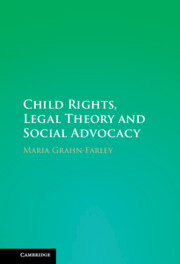Book contents
- Child Rights, Legal Theory and Social Advocacy
- Child Rights, Legal Theory and Social Advocacy
- Copyright page
- Dedication
- Contents
- Acknowledgments
- Introduction
- 1 The Child and Human Rights
- 2 The Monist Construction of the Child
- 3 The Complex Intersectionality of the Child
- 4 Heard but Unable to Speak
- 5 The Child in the Child Rights Movement
- 6 The Child in the Exception
- 7 The Monist Pull of Universalization
- 8 The Monist Child-Rights Identity and Universal Positivism
- Bibliography
- Index
3 - The Complex Intersectionality of the Child
Published online by Cambridge University Press: 07 November 2024
- Child Rights, Legal Theory and Social Advocacy
- Child Rights, Legal Theory and Social Advocacy
- Copyright page
- Dedication
- Contents
- Acknowledgments
- Introduction
- 1 The Child and Human Rights
- 2 The Monist Construction of the Child
- 3 The Complex Intersectionality of the Child
- 4 Heard but Unable to Speak
- 5 The Child in the Child Rights Movement
- 6 The Child in the Exception
- 7 The Monist Pull of Universalization
- 8 The Monist Child-Rights Identity and Universal Positivism
- Bibliography
- Index
Summary
Making the child-rights identity detached from its social context and the possibility of self-identification serves to protect the child from traditional and social harmful practices directed toward children. At the same time, the monist identity of the child becomes placed out of reach of democratic deliberations and self-determination. The intersectionality of race and gender becomes two socially constructed concepts that cannot be addressed within the child-rights identity, which both serves to protect the child from discrimination but also risks making child rights detached from addressing crucial structural inequalities based on race and gender.
- Type
- Chapter
- Information
- Child Rights, Legal Theory and Social Advocacy , pp. 59 - 82Publisher: Cambridge University PressPrint publication year: 2024

